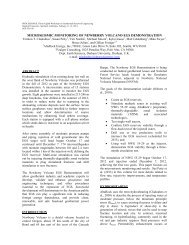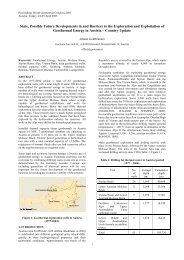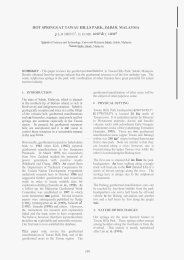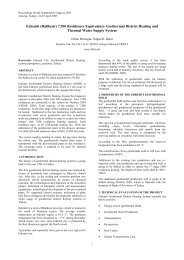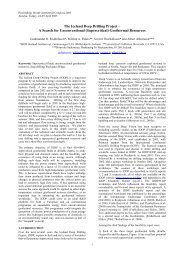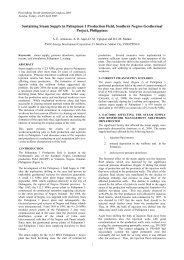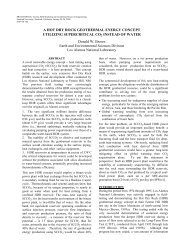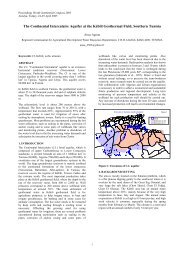magnetotelluric interpretation of the karaha bodas geothermal field ...
magnetotelluric interpretation of the karaha bodas geothermal field ...
magnetotelluric interpretation of the karaha bodas geothermal field ...
Create successful ePaper yourself
Turn your PDF publications into a flip-book with our unique Google optimized e-Paper software.
PROCEEDINGS, Twenty-Seventh Workshop on Geo<strong>the</strong>rmal Reservoir Engineering<br />
Stanford University, Stanford, California, January 28-30, 2002<br />
SGP-TR-171<br />
MAGNETOTELLURIC INTERPRETATION OF THE KARAHA BODAS GEOTHERMAL<br />
FIELD INDONESIA<br />
Imam Raharjo 1,4 , Phil Wannamaker 2 , Rick Allis 3 , David Chapman 1<br />
1 Dept. <strong>of</strong> Geology and Geophysics, University <strong>of</strong> Utah, Salt Lake City<br />
2 Energy and Geosciences Institute, University <strong>of</strong> Utah, Salt Lake City<br />
3 Utah Geological Survey, Salt Lake City<br />
4 Pertamina Geo<strong>the</strong>rmal, Jakarta<br />
iraharjo@mines.utah.edu<br />
ABSTRACT<br />
The Karaha Bodas Field is a vapor-type geo<strong>the</strong>rmal<br />
system having a temperature <strong>of</strong> up to 350°C. The<br />
reservoir is hosted in a volcanic environment<br />
comprises <strong>of</strong> tuff breccias with minor andesite lavas,<br />
and quartz diorite intrusions. Based on <strong>the</strong> surface<br />
<strong>the</strong>rmal distribution <strong>the</strong> system might occupy an area<br />
<strong>of</strong> 5x13 km 2 . One hundred and eighty <strong>magnetotelluric</strong><br />
(MT) stations recorded in 1996 and 1997 were used<br />
to assess <strong>the</strong> clay cap extension. One -dimensional<br />
MT <strong>interpretation</strong>s were performed. A north-south<br />
MT pr<strong>of</strong>ile crossing <strong>the</strong> entire <strong>field</strong> was chosen to<br />
show <strong>the</strong> extent <strong>of</strong> <strong>the</strong> possible resources. The pr<strong>of</strong>ile<br />
shows a very thick conductive layer (1-10Ω m)<br />
extending 7 km northward from <strong>the</strong> Bodas Crater.<br />
The thickness <strong>of</strong> <strong>the</strong> conductive layer is about 1000-<br />
1200 m having a base at about 200-300 meters above<br />
sea level. Between 7-12 km north <strong>of</strong> <strong>the</strong> crater <strong>the</strong><br />
layer thins (to 700 m), and <strong>the</strong> resistivity increases<br />
slightly to 14Ω m. The interface between <strong>the</strong><br />
conductive layer and <strong>the</strong> underlying layer also<br />
coincides with fluid loss zones during drilling<br />
operation. This observation suggests that <strong>the</strong><br />
conductive layer is still <strong>the</strong> clay cap <strong>of</strong> <strong>the</strong> reservoir.<br />
O<strong>the</strong>r, and more complex, resistivity structures<br />
caused by multiple hydro<strong>the</strong>rmal processes are not<br />
imaged by <strong>the</strong> MT data. At a distance <strong>of</strong> 12 km from<br />
<strong>the</strong> crater <strong>the</strong> conductive layer vanishes. Some<br />
<strong>the</strong>rmal springs and steaming ground also occur,<br />
suggesting <strong>the</strong> nor<strong>the</strong>rn boundary <strong>of</strong> <strong>the</strong> system.<br />
INTRODUCTION<br />
The Karaha Bodas Field is a vapor-dominated<br />
system, located in West Java, Indonesia. The<br />
temperature <strong>of</strong> <strong>the</strong> reservoir varies from about 250°<br />
to up to 350°C. The hottest part <strong>of</strong> <strong>the</strong> <strong>field</strong> is <strong>the</strong><br />
Bodas Area in <strong>the</strong> south. The temperature trend<br />
gradually decreases northward down to probably<br />
250° in <strong>the</strong> Karaha Block on <strong>the</strong> north side.<br />
Consequently, <strong>the</strong> main <strong>the</strong>rmal surface activities<br />
over <strong>the</strong> area consist <strong>of</strong> fumaroles, an acidic lake,<br />
and hot springs in Bodas Area, while in <strong>the</strong> Karaha<br />
Area altered ground associated with steaming ground<br />
occur toge<strong>the</strong>r with some <strong>the</strong>rmal springs. Overall,<br />
<strong>the</strong> reservoir temperature is hotter than <strong>the</strong> adjacent<br />
vapor geo<strong>the</strong>rmal <strong>field</strong> Kamojang with temperature<br />
to 225°C. The shallow hydro<strong>the</strong>rmal circulation<br />
combined with <strong>the</strong> condensed steam on <strong>the</strong> upper part<br />
<strong>of</strong> <strong>the</strong> reservoir forms a clay cap. This acts as a<br />
conductive blanket that covers <strong>the</strong> entire reservoir. In<br />
a mountainous area like this, topography drives <strong>the</strong><br />
shallow hydro<strong>the</strong>rmal circulation. This paper is a<br />
preliminary effort to image <strong>the</strong> gross resistivity<br />
structure <strong>of</strong> <strong>the</strong> <strong>field</strong> and to delineate <strong>the</strong> possible<br />
reservoir boundary.<br />
Figure 1. Location Map <strong>of</strong> <strong>the</strong> Karaha Bodas<br />
Geo<strong>the</strong>rmal Field. Darajat (55 MW) and<br />
Kamojang (140 MW) are vapordominated<br />
reservoirs.
METHOD<br />
We use <strong>magnetotelluric</strong>s delineate <strong>the</strong> extent <strong>of</strong><br />
possible resources. One-dimensional forward and<br />
inverse modeling is employed. These results are<br />
compared to downhole temperature measurements,<br />
<strong>the</strong> surface <strong>the</strong>rmal manifestations, and <strong>the</strong> depth <strong>of</strong><br />
circulation loss during drilling.<br />
PREVIOUS WORK<br />
Geophysical surveys that have been completed<br />
include gravity, DC Schlumberger, and<br />
Magnetotellurics. Twenty six wells have also been<br />
drilled. Papers discussing Karaha include<br />
<strong>magnetotelluric</strong>s <strong>interpretation</strong> (GENZL, 1997),<br />
evolution <strong>of</strong> <strong>the</strong> <strong>field</strong> (Allis and Moore, 2000), and<br />
<strong>the</strong> Karaha hydro<strong>the</strong>rmal system (Allis, et.al., 2000).<br />
Karaha is a two hours drive from Bandung making<br />
this <strong>field</strong> area very accessible. It sits on <strong>the</strong> north<br />
flank <strong>of</strong> <strong>the</strong> Galunggung which erupted in 1982<br />
(Figure 1).<br />
kilometer<br />
9212<br />
9210<br />
9208<br />
9206<br />
1250<br />
1500<br />
1250<br />
1000<br />
1500<br />
KarahaArea<br />
1250<br />
1500<br />
1000<br />
1000<br />
1250<br />
P-1<br />
1250<br />
1250<br />
1000<br />
1250<br />
1500<br />
KM101<br />
1250<br />
1000<br />
1000<br />
750<br />
P-2<br />
750<br />
<strong>field</strong> is covered by Quarternary volcanic debris<br />
interlayered with minor andesite lavas having<br />
thickness <strong>of</strong> up to 100 m. Some dark colored lake<br />
sediments were also encountered during drilling and<br />
are dated back to be as old as 6000 years (Moore,<br />
2001, private communication). Quartz diorite<br />
intrusions are found in <strong>the</strong> center and north part <strong>of</strong><br />
<strong>the</strong> <strong>field</strong> at an elevation <strong>of</strong> about 1 km below sea<br />
level. These intrusions toge<strong>the</strong>r with ano<strong>the</strong>r<br />
magmatic chamber beneath Galunggung Volcano are<br />
believed to provide <strong>the</strong> heat source for <strong>the</strong> <strong>field</strong>. At<br />
lower elevation Sedimentary deposits are found.<br />
The <strong>field</strong> is characterized by a prominent north-south<br />
volcanic ridge, comprising several volcanic peaks.<br />
MAGNETOTELLURIC THEORY<br />
The <strong>magnetotelluric</strong>s (MT) method is a natural-<strong>field</strong><br />
electromagnetic method utilizing <strong>the</strong> <strong>field</strong> induced by<br />
magnetospheric or ionospheric current. Since <strong>the</strong><br />
source is far away, <strong>the</strong> <strong>field</strong> can be treated as a plane<br />
wave (Zhdanov and Keller, 1998). The second<br />
<strong>the</strong>orem <strong>of</strong> <strong>the</strong> Maxwell equation states that<br />
curl E = -∂B/∂t, (3.1)<br />
where E is an Electric <strong>field</strong> and B is magnetic <strong>field</strong>.<br />
Since a plane wave is utilized (E z =0) and MT<br />
frequency used is usually low, <strong>the</strong> equation can be<br />
expanded into<br />
⎡ dx dy dx ⎤<br />
⎢<br />
⎥<br />
⎢∂<br />
/ ∂x<br />
∂ / ∂y<br />
∂ / dz⎥<br />
= −iϖµ<br />
0(<br />
H<br />
xd<br />
x<br />
+ H<br />
ydY<br />
)<br />
⎢ Ex<br />
E<br />
y<br />
0 ⎥<br />
⎣<br />
⎦<br />
(3.2)<br />
where B=µ 0 H. (3.3)<br />
1250<br />
9204<br />
9202<br />
1000<br />
1250<br />
1250<br />
BodasArea<br />
1500<br />
1750<br />
2000<br />
1500<br />
1750<br />
1500<br />
1500<br />
1250<br />
1000<br />
1000<br />
P-3<br />
Recall that vertical plane wave does not have<br />
derivatives in x and y direction. By expanding<br />
equation (3.2), we end up with two independent<br />
equations :<br />
1 dEy<br />
H<br />
x<br />
= − , and<br />
1 dEx<br />
H<br />
y<br />
= . (3.4)<br />
iϖµ<br />
0<br />
dz<br />
iϖµ<br />
dz<br />
0<br />
172 173 174 175 176 177 178 179 180<br />
kilometer<br />
Figure 2. Situation map <strong>of</strong> <strong>the</strong> <strong>field</strong>. The contour<br />
interval is 250. Fumaroles are shown as<br />
stars, <strong>the</strong>rmal springs are shown as<br />
circles and diamond shape marks. MT<br />
sitesareshownasplusmarks.<br />
GEOLOGY<br />
Geologic Mapping (Ganda, et. al. 1985) and <strong>the</strong><br />
wellbore data (EGI, 2001) indicate that <strong>the</strong> entire<br />
From this point one can apply a solution <strong>of</strong><br />
Helmholtz operator to <strong>the</strong> equations to yield a simple<br />
relationship between electric <strong>field</strong> (E) and magnetic<br />
<strong>field</strong> (H) to its impedance (Z)<br />
Z<br />
xy<br />
Ex<br />
() z<br />
=<br />
H () z<br />
, and<br />
y<br />
Z<br />
yx<br />
Ey<br />
( z)<br />
= − . (3.5)<br />
H ( z)<br />
Fur<strong>the</strong>rmore, one can derive <strong>the</strong> corresponding<br />
apparent resistivity which are<br />
x
ρ<br />
xy<br />
= 1 Zxy<br />
2 , and ρ<br />
ϖµ<br />
0<br />
yx=<br />
1<br />
ϖµ<br />
0<br />
Zyx<br />
2 . (3.6)<br />
In this general case, electric and magnetic <strong>field</strong>s are a<br />
function <strong>of</strong> conductivity (σ), dielectric permitivity<br />
(ε), and magnetic permeability (µ) <strong>of</strong><strong>the</strong>material.<br />
This relationship can be formulated as<br />
{ EH , } A( , , )<br />
= σ ε µ (3.7)<br />
where A is a forward operator applied into σ,ε, and<br />
µ. Keep in mind that σ is just simply 1/ρ. The<br />
corresponding inverse problem is<br />
{ σεµ , , } = − 1<br />
A { E,<br />
H}<br />
(3.8)<br />
In most presentations, E and H are usually combined<br />
toge<strong>the</strong>r as an apparent resistivity ρ a , ρ xy or ρ yx .This<br />
is a nonlinear problem, <strong>the</strong>refore finding <strong>the</strong> forward<br />
operator A is sometimes ra<strong>the</strong>r complicated. One <strong>of</strong><br />
many simplest one-dimensional forward operators is<br />
<strong>the</strong> reflectivity coefficient, R N (Zhdanov, and Keller,<br />
1998). The result is used to develop a forward model,<br />
as followings.<br />
Given N layers, <strong>the</strong> reflectivity coefficient <strong>of</strong> <strong>the</strong><br />
most bottom interface is<br />
R 1<br />
= 1. (3.9)<br />
The reflectivity coefficients for <strong>the</strong> next j layers (R 2 )<br />
to <strong>the</strong> earth surface (R N ) can be calculated as,<br />
where<br />
( ikud ( N j )<br />
K( j)<br />
e<br />
R( j)<br />
= − −2 − + 1<br />
1<br />
( −2ikud ( N − j+<br />
1)<br />
1+<br />
K( j)<br />
e<br />
ku<br />
1−<br />
K j kl R ( j −1)<br />
( ) =<br />
; (3.11)<br />
ku<br />
1+ kl R ( j −1)<br />
ku = ( iϖµ 0<br />
σ ( N − j + 1)) ;<br />
(3.10)<br />
kl = ( iϖµ 0<br />
σ ( N − j + 2)) , (3.12)<br />
and d is thickness <strong>of</strong> <strong>the</strong> layers. At <strong>the</strong> very bottom<br />
interface <strong>the</strong> K(1) is also equal to one. To obtain a<br />
series <strong>of</strong> ρ a curve, <strong>the</strong>se equations should be looped<br />
over <strong>the</strong> desired period, as shown in <strong>the</strong> attached<br />
MATLAB codes (Appendix-1).<br />
The inversion code uses a least-squared method<br />
which utilizes Marquadt’s stabilizer (Wannamaker,<br />
1990). The method is a special case in Tikhonov’s<br />
parametric function. If we recall <strong>the</strong> forward operator<br />
A, and apply it to a model m, <strong>the</strong>n Am is <strong>the</strong><br />
predicted data. The idea <strong>of</strong> <strong>the</strong> least-squared method<br />
is minimize <strong>the</strong> difference between <strong>the</strong> observed data<br />
(d) with <strong>the</strong> predicted data Am. This value is called<br />
misfit function,<br />
2<br />
f ( m) = Am − d) = ( Am −d, Am − d) = min. (3.13)<br />
Using matrix notation this equation can be rewritten<br />
as<br />
T<br />
f ( m) = ( Am−d) ( Am− d) = min (3.14)<br />
After applying variational calculus to equation (3.14),<br />
<strong>the</strong> solution gives <strong>the</strong> model m o ,<br />
T −1<br />
T<br />
m = ( A A A d (3.15)<br />
0<br />
)<br />
In most cases <strong>the</strong> inverse <strong>of</strong> (A T A) does ei<strong>the</strong>r not<br />
exist or close to singular. Therefore Tikhonov<br />
(Zhdanov and Keller, 1998) introduced a stabilizer<br />
coefficient α, an apriori model m apr , and some<br />
weighting matrices <strong>of</strong> data (W d ) and model (W M )<br />
that give more stable solution,<br />
T 2 2 −1 T 2 2<br />
mα = ( A W A+ αW ) ( A W + αW m ). (3.16)<br />
d<br />
m<br />
d m apr<br />
Marquadt method simplifies W d =I and W M =I, m apr<br />
=0, and uses singular value decomposition to<br />
represent <strong>the</strong> forward operator A as (UQV) T .Inthis<br />
case U is a column-orthogonal matrix, Q is a<br />
diagonal matrix, and V is a square orthogonal matrix.<br />
The solution is <strong>the</strong>n<br />
T<br />
−1<br />
T ⎡ 1 ⎤ T T<br />
m = ( A A + αI)<br />
A d = V ⎢ Q U d.<br />
(3.17)<br />
α<br />
2<br />
Q I<br />
⎥<br />
⎣ + α ⎦<br />
Because this is non linear problem, <strong>the</strong> least-squared<br />
solution has to be iterated until <strong>the</strong> misfit reaches a<br />
desirable error.<br />
DATA AVAILABLE<br />
On behalf <strong>of</strong> Karaha Bodas Company, in 1996 and<br />
1997 Geosystems undertook MT measurements in<br />
<strong>the</strong> <strong>field</strong>. Half <strong>of</strong> <strong>the</strong> stations were scattered over <strong>the</strong><br />
<strong>field</strong>, and <strong>the</strong> rest were aligned into 5 dense lines<br />
(Figure 2). These data are available through EGI in<br />
EDI ASCII format. Remote reference procedure was<br />
deployed to minimize error. This yield good quality<br />
data, as shown by <strong>the</strong> plot <strong>of</strong> <strong>the</strong> resistivity curves<br />
and <strong>the</strong> corresponding error bars (Figure 5). One<br />
hundred and eighty stations were selected for this<br />
study. Prior to <strong>the</strong> <strong>interpretation</strong> stage, static shift<br />
correction have been applied utilizing TDEM data,<br />
using a simple MATLAB code.
MT INVARIANT APPARENT RESISTIVITY<br />
MAPS<br />
Gross resistivity structure <strong>of</strong> <strong>the</strong> <strong>field</strong> are recognized<br />
from resistivity maps. One <strong>of</strong> <strong>the</strong>se is invariant<br />
apparent resistivity map, which is <strong>the</strong> geometric<br />
mean <strong>of</strong> ρ xy and ρ yx :<br />
ρ = ( ρ × ρ ) .<br />
inv xy yx<br />
05 (3.18)<br />
Figures 3 and 4 show resistivity maps constructed at<br />
periods <strong>of</strong> 0.25 s and 1.0s, respectively.<br />
kilometer<br />
9214<br />
9212<br />
9210<br />
9208<br />
9206<br />
9204<br />
9202<br />
14<br />
KarahaArea<br />
14<br />
22<br />
14<br />
BodasArea<br />
10<br />
6<br />
14<br />
10<br />
14<br />
10<br />
22<br />
14<br />
22<br />
10<br />
22<br />
1414<br />
6<br />
14<br />
14<br />
9200<br />
171 172 173 174 175 176 177 178 179 180 181<br />
kilometer<br />
14<br />
14<br />
10<br />
14<br />
6<br />
10<br />
10<br />
6<br />
10<br />
14<br />
14<br />
22<br />
22<br />
10<br />
10<br />
30<br />
10<br />
6<br />
22<br />
22<br />
66<br />
14<br />
KM101<br />
Figure 3. MT invariant apparent resistivity map at a<br />
period <strong>of</strong> 0.25s showing a shallow<br />
conductor in <strong>the</strong> Bodas Area. Contours<br />
are in Ohm.m.<br />
A shallow low resistivity zone (
10 2<br />
Forward modeling <strong>of</strong> Sounding KM101- static shifted<br />
employs ten layers shows gradually-changing layers<br />
having a minimum value <strong>of</strong> about 5 Ω.m. The total<br />
thickness <strong>of</strong> <strong>the</strong> conductive layers is about 900m.<br />
10 3 ...... TDEM derived MT<br />
ρ a<br />
[Ω .m]<br />
10 1<br />
10 0<br />
10 -1<br />
o:Rho XY, +:Rho YX<br />
Rho (Ω.m) :110,10,60<br />
Interface (m) :400,1400,inf<br />
10 -3 10 -2 10 -1 10 0 10 1 10 2 10 3<br />
10 2<br />
Period [second]<br />
Inverse modeling <strong>of</strong> Sounding KM101- static shifted<br />
Forward and inverse modeling was undertaken to<br />
interpret all MT sites. Three sections were <strong>the</strong>n<br />
constructed having directions shown in Figure 2.<br />
Pr<strong>of</strong>ile-1 is running north-south and is displayed in<br />
both forward and inverse model. Pr<strong>of</strong>ile-2 and<br />
Pr<strong>of</strong>ile-3 are run west-east and are displayed in<br />
inverse models only. Before discussing <strong>the</strong>se pr<strong>of</strong>iles<br />
in detailed, it is important to understand <strong>the</strong><br />
geohydrology <strong>of</strong> <strong>the</strong> system.<br />
10 3 ...... TDEM derived MT<br />
ρ a<br />
[Ω .m]<br />
10 1<br />
10 0<br />
10 -1<br />
o:Rho XY, +:Rho YX<br />
Rho (Ω.m) :97.7,188.8,20.6,7.5,12.9,6.8,5.1,11.7,15.7,55.2<br />
Interface (m) :139.8,401.7,539.1,693.4,859.1,995.4,1139.2,1271.7,1368.7,inf<br />
10 -3 10 -2 10 -1 10 0 10 1 10 2 10 3<br />
Period [second]<br />
Figure 5. One-dimensional forward and inverse<br />
modeling <strong>of</strong> <strong>the</strong> MT site KM101 located in<br />
<strong>the</strong> Karaha Area.<br />
Elevation (m)<br />
2000<br />
1000<br />
0<br />
-1000<br />
-2000<br />
S P1 (forward mode)<br />
14<br />
2<br />
? 1-10 Ohm.m<br />
300<br />
resistive<br />
11<br />
3<br />
50<br />
4km<br />
Figure 6. Pr<strong>of</strong>ile-1 showing a conductive layer<br />
having a tongue shape vanishes to <strong>the</strong><br />
north from forward modeling.<br />
Elevation (m)<br />
2000<br />
1000<br />
0<br />
-1000<br />
-2000<br />
S<br />
31 4<br />
1<br />
3<br />
10<br />
? 13 1-10Ohm.m<br />
10<br />
6<br />
3<br />
99<br />
resistive<br />
10<br />
2 2<br />
4<br />
88<br />
4km<br />
Figure 7. Pr<strong>of</strong>ile-1 showing a conductive layer<br />
having a tongue shape vanishes to <strong>the</strong><br />
north from inverse modeling<br />
The MT record from this site shows a 1-D<br />
environment. i.e. <strong>the</strong>re is not a severe split between<br />
ρ xy and ρ yx . The forward and inverse models <strong>of</strong> <strong>the</strong><br />
curveareshowninFigure5.Ingeneral,<strong>the</strong>curves<br />
suggest a three layers structure, comprise <strong>of</strong> resistiveconductive-resistive<br />
layers. The forward model<br />
shows a thick conductive layer (10Ω.m, 1000m) at a<br />
depth <strong>of</strong> about 300m. The inverse model which<br />
10<br />
1.5<br />
300<br />
14 2<br />
1<br />
1<br />
2<br />
3<br />
4<br />
4<br />
4<br />
53<br />
25 6<br />
2<br />
50<br />
20<br />
18 3<br />
2<br />
67<br />
15<br />
5<br />
250<br />
16<br />
12<br />
5<br />
10<br />
3<br />
6<br />
7<br />
7<br />
7<br />
315<br />
100<br />
10 3<br />
100<br />
69<br />
5<br />
14<br />
126<br />
30 5<br />
1<br />
20<br />
200<br />
8<br />
300<br />
150<br />
40<br />
8<br />
250<br />
P1 (inverse mode)<br />
20<br />
5<br />
1<br />
8<br />
5<br />
1<br />
7<br />
25<br />
4<br />
214<br />
175<br />
90<br />
9<br />
616<br />
150<br />
64<br />
25<br />
15<br />
15<br />
4<br />
21<br />
11<br />
54<br />
5-1<br />
Oh<br />
Topography plays important role in groundwater<br />
movement in a mountainous area, i.e. <strong>the</strong> hydraulic<br />
gradient in <strong>the</strong> flank drives <strong>the</strong> deeper groundwater<br />
movement. Fortunately one can draw a rough<br />
groundwater movement based on <strong>the</strong> topographic<br />
terrain, since <strong>the</strong> shape <strong>of</strong> <strong>the</strong> water table is usually<br />
concordant with <strong>the</strong> topography. Following this rule,<br />
hydro<strong>the</strong>rmal fluid arising from <strong>the</strong> deeper part <strong>of</strong> <strong>the</strong><br />
upflow zone will flow to <strong>the</strong> flank <strong>of</strong> <strong>the</strong> volcano.<br />
Hot, warm, or even coldsprings on <strong>the</strong> volcano flanks<br />
are <strong>the</strong> evidence <strong>of</strong> downhill fluid movement. As a<br />
consequence, a tongue shape alteration from upflow<br />
to <strong>the</strong> outflow zone is common in andesitic hosted<br />
geo<strong>the</strong>rmal system. If this hydro<strong>the</strong>rmal fluid<br />
movement has enough time to alter <strong>the</strong> host rock, one<br />
might able to map <strong>the</strong> associated low resistivity layer.<br />
The forward and inverse models on <strong>the</strong> Pr<strong>of</strong>ile-1<br />
generally agree, both have a 12 km long conductive<br />
layer. The thickness from <strong>the</strong> inverse modeling is<br />
somewhat greater. The layer has a tongue shape<br />
which vanishes to <strong>the</strong> north. Based on <strong>the</strong> inverse<br />
modeling, <strong>the</strong> thickness <strong>of</strong> <strong>the</strong> layer is about one<br />
1000-1200 meter in <strong>the</strong> Bodas Area. The top <strong>of</strong> layer<br />
deepens to <strong>the</strong> north, and <strong>the</strong>n goes up again to reach<br />
<strong>the</strong> surface in <strong>the</strong> north end. The thickness is also<br />
decreasing to about 700 m. The resistivity values in<br />
<strong>the</strong> conductive layer can also be grouped into south<br />
layer and north layer. The south layer resistivity<br />
ranges from 1 to 10 Ω.m, while <strong>the</strong> north layer<br />
resistivity ranges from 5 to 14 Ω.m .<br />
The tips <strong>of</strong> <strong>the</strong> layer in <strong>the</strong> west east direction are not<br />
recognized from <strong>the</strong> corresponding pr<strong>of</strong>iles, due to<br />
<strong>the</strong> lack <strong>of</strong> data. Figures 8 and 9 show <strong>the</strong> two<br />
pr<strong>of</strong>iles. However a downhill trend conductor can be<br />
clearly seen from <strong>the</strong> pr<strong>of</strong>iles. Surprisingly <strong>the</strong><br />
thickness <strong>of</strong> <strong>the</strong> layer in <strong>the</strong> flank is thicker in <strong>the</strong><br />
north pr<strong>of</strong>ile compared to <strong>the</strong> south pr<strong>of</strong>ile. This<br />
leads to a preliminary guess that <strong>the</strong> north part has<br />
more downhill flow compared to <strong>the</strong> south.<br />
Integration and <strong>interpretation</strong> with o<strong>the</strong>r methods are
needed to determine reservoir boundaries in west east<br />
direction not discussed in this paper.<br />
If we recall <strong>the</strong> pr<strong>of</strong>ile-1 and compare <strong>the</strong> extent <strong>of</strong><br />
<strong>the</strong> layer with o<strong>the</strong>r subsurface data, such as <strong>the</strong><br />
temperature pr<strong>of</strong>ile, <strong>the</strong> depth <strong>of</strong> circulation loss<br />
zone, and <strong>the</strong> <strong>the</strong>rmal manifestations, some<br />
<strong>interpretation</strong> can be made. Figure 10 shows <strong>the</strong><br />
extent <strong>of</strong> <strong>the</strong> conductive layer superimposed on some<br />
subsurface data. At <strong>the</strong> Bodas Area <strong>the</strong> conductive<br />
layer is concordant with <strong>the</strong> temperature region <strong>of</strong><br />
100-260°C. The upper part <strong>of</strong> <strong>the</strong> region mostly<br />
comprises <strong>of</strong> argillic type alteration (Moore, 2001.<br />
private comm.). This region has a low conductivity <strong>of</strong><br />
1-10 Ωm. If we recall that <strong>the</strong> Bodas crater is <strong>the</strong><br />
upflow zone <strong>of</strong> <strong>the</strong> <strong>field</strong> (Allis, et. al., 2000), <strong>the</strong>n<br />
extent <strong>of</strong> <strong>the</strong> layer from <strong>the</strong> upflow zone is about 7<br />
km to <strong>the</strong> north. The base <strong>of</strong> <strong>the</strong> layer is about 200-<br />
300 meter above sea level. This range coincides with<br />
<strong>the</strong> top loss zone <strong>of</strong> <strong>the</strong> reservoir. This implies that<br />
<strong>the</strong> layer is still <strong>the</strong> clay cap <strong>of</strong> <strong>the</strong> reservoir. Keep in<br />
mind that <strong>the</strong> resistivity <strong>of</strong> a vapor reservoir is<br />
usually slightly higher than <strong>the</strong> resistivity <strong>of</strong> <strong>the</strong> clay<br />
cap. The layer becomes thinner (to 700 m) as it goes<br />
from7to12kmnorthwardin<strong>the</strong>KarahaArea.The<br />
resistivity range <strong>of</strong> <strong>the</strong> layer also increases slightly to<br />
5-14Ω m. This might be related to <strong>the</strong> fact that<br />
alteration process in <strong>the</strong> Karaha Area is not as<br />
vigorous as those in Bodas area. At a distance <strong>of</strong> 12<br />
km from <strong>the</strong> Bodas crater <strong>the</strong> layer vanishes. Some<br />
cold springs and altered ground also occur,<br />
suggesting <strong>the</strong> nor<strong>the</strong>rn boundary <strong>of</strong> <strong>the</strong> system. The<br />
most likely geo<strong>the</strong>rmal reservoir is shown in <strong>the</strong><br />
Figure 10.<br />
Elevation (m)<br />
2000<br />
1000<br />
0<br />
-1000<br />
-2000<br />
W P2 (inverse mode) E<br />
33<br />
24<br />
19<br />
18<br />
16<br />
12<br />
9<br />
9<br />
5<br />
? 4 - 10 Ohm.m ?<br />
198<br />
resistive<br />
4km<br />
Figure 8. Pr<strong>of</strong>ile-2 showing a conductive layer in <strong>the</strong><br />
west east direction from inverse modeling.<br />
Elevation (m)<br />
2000<br />
1000<br />
0<br />
-1000<br />
-2000<br />
W P3 (inverse mode) E<br />
?<br />
4km<br />
resistive<br />
279<br />
185<br />
82<br />
26<br />
10 8<br />
7<br />
7<br />
5<br />
590<br />
2-10 Ohm.m<br />
Figure 9. Pr<strong>of</strong>ile-3 showing a conductive layer in <strong>the</strong><br />
west east direction from inverse modeling<br />
175<br />
31<br />
29 8<br />
14 7<br />
16<br />
7<br />
12<br />
183<br />
84<br />
37<br />
46<br />
3<br />
16<br />
13 4<br />
6<br />
8<br />
99<br />
?<br />
Figure 10. The extent <strong>of</strong> <strong>the</strong> conductive layer<br />
superimposed on Allis et.al. model, 2000.<br />
The layer is shown in shaded region. The<br />
dotted line is <strong>the</strong> depth <strong>of</strong> <strong>the</strong> top loss zone<br />
during drilling.<br />
CONCLUSIONS AND FURTHER WORK<br />
The following conclusions summarize <strong>the</strong> discussion,<br />
• The extent <strong>of</strong> <strong>the</strong> conductive layer in <strong>the</strong> northsouth<br />
pr<strong>of</strong>ile can be used to delineate <strong>the</strong><br />
nor<strong>the</strong>rn boundary<br />
• In general <strong>the</strong> conductive layer coincides with<br />
<strong>the</strong> temperatures <strong>of</strong> 100-260°C<br />
• The base <strong>of</strong> <strong>the</strong> conductor is concordant with <strong>the</strong><br />
depth pf circulation loss zone, suggesting that <strong>the</strong><br />
layer is still acting as <strong>the</strong> cap <strong>of</strong> <strong>the</strong> system.<br />
To obtain a better image <strong>of</strong> <strong>the</strong> resistivity structure <strong>of</strong><br />
Karaha, we plan to perform 2-D MT modeling using<br />
a finite element method Program (Wannamaker,<br />
1990).<br />
ACKNOWLEDGMENT<br />
The principal author would like to thank to <strong>the</strong> EGI<br />
for providing <strong>the</strong> data, and to <strong>the</strong> World Bank<br />
through <strong>the</strong> JJ/WBGSP for providing <strong>the</strong> fellowship<br />
at <strong>the</strong> University <strong>of</strong> Utah.<br />
REFERENCES<br />
Allis, R., Moore, J.N. (2000), "Evolution <strong>of</strong> Volcano-<br />
Hosted Vapor-Dominated Geo<strong>the</strong>rmal Systems”,<br />
Geo<strong>the</strong>rmal Resources Council Transaction, Vol.24,<br />
211-216.<br />
Allis, R., et.al. (2000), "Karaha-Telaga Bodas,<br />
Indonesia: A Partially Vapor-Dominated Geo<strong>the</strong>rmal<br />
Systems”, Geo<strong>the</strong>rmal Resources Council<br />
Transaction, Vol.24, 217-222.<br />
GENZL (1997), “Survey Report, Karaha Telaga<br />
Bodas MT Survey - 1997”, prepared for Karaha<br />
Bodas Co., unpublished,
Ganda, S., Boedihardi, M., Rachman, A., and<br />
Hantono, D. (1985), “Geologi Daerah Kawah<br />
Kamojang dan Sekitarnya, Kabupaten Tasikmalaya,<br />
Garut, Majalengka, dan Sumedang, Propinsi Jawa<br />
Barat”, Divisi Geo<strong>the</strong>rmal, Pertamina Pusat.<br />
EGI, (2001), “Downhole Karaha Data”, unpublished,<br />
Energy and Geoscience Institute,<br />
Wannamaker, P.E. (1990), "Finite Element Program<br />
for Magnetotelluric Forward Modeling and<br />
Parameterized Inversion <strong>of</strong> Two-Dimensional Earth<br />
Resistivity Structure”, University <strong>of</strong> Utah Research<br />
Institute, 41 pages.<br />
Zhdanov, M.S., Keller, G.V. (1998), "The<br />
Geoelectrical Methods In Geophysical Exploration”,<br />
Method In Geochemistry and Geophysics, 31, 261-<br />
346.<br />
APPENDIX-1<br />
% MT Rn - code to run a 1-D MT modeling<br />
clear all;<br />
Rho=[100 10 1000];<br />
depth=[500 1000]; % interface depth<br />
nlayer=length(Rho);<br />
d(1)=depth(1); % thickness<br />
for j=2:nlayer-1,<br />
d(j)=depth(j)-depth(j-1);<br />
end;<br />
maxcount=81;<br />
u0=4*pi*10^-7;<br />
xplot=zeros(maxcount,1);<br />
R=zeros(nlayer,1);<br />
K=zeros(nlayer,1);<br />
To=zeros(maxcount,1);<br />
Rn=zeros(maxcount,1);<br />
Ph=zeros(maxcount,1);<br />
% --- for a series <strong>of</strong> frequencies<br />
pow=-3;<br />
for n=1:maxcount;<br />
To(n)=10^(pow);pow=pow+.1;<br />
end<br />
R(1)=1;K(1)=1;<br />
for nf=1:maxcount, % Loop over a series <strong>of</strong> frequencies<br />
w=2*pi/To(nf);<br />
for n=2:nlayer,<br />
ku=(i*w*u0/Rho(nlayer-n+1))^.5;<br />
kl=(i*w*u0/Rho(nlayer-n+2))^.5;<br />
K(n)=(1-ku/kl*R(n-1))/ ...<br />
(1+ku/kl*R(n-1));<br />
R(n)=(1-K(n)*exp(2*i*ku*d(nlayer-n+1)))/ ...<br />
(1+K(n)*exp(2*i*ku*d(nlayer-n+1)));<br />
end;<br />
Rn(nf)=Rho(1)*abs(R(nlayer)^2);<br />
end;<br />
loglog(To,Rn,'b.')<br />
axis([1E-3 1E3 1E0 1E4]);<br />
xlabel('T second');<br />
ylabel('\rho_a_p_p \Omegam');<br />
title('Apparent resistivity for an n-layered earth ').



